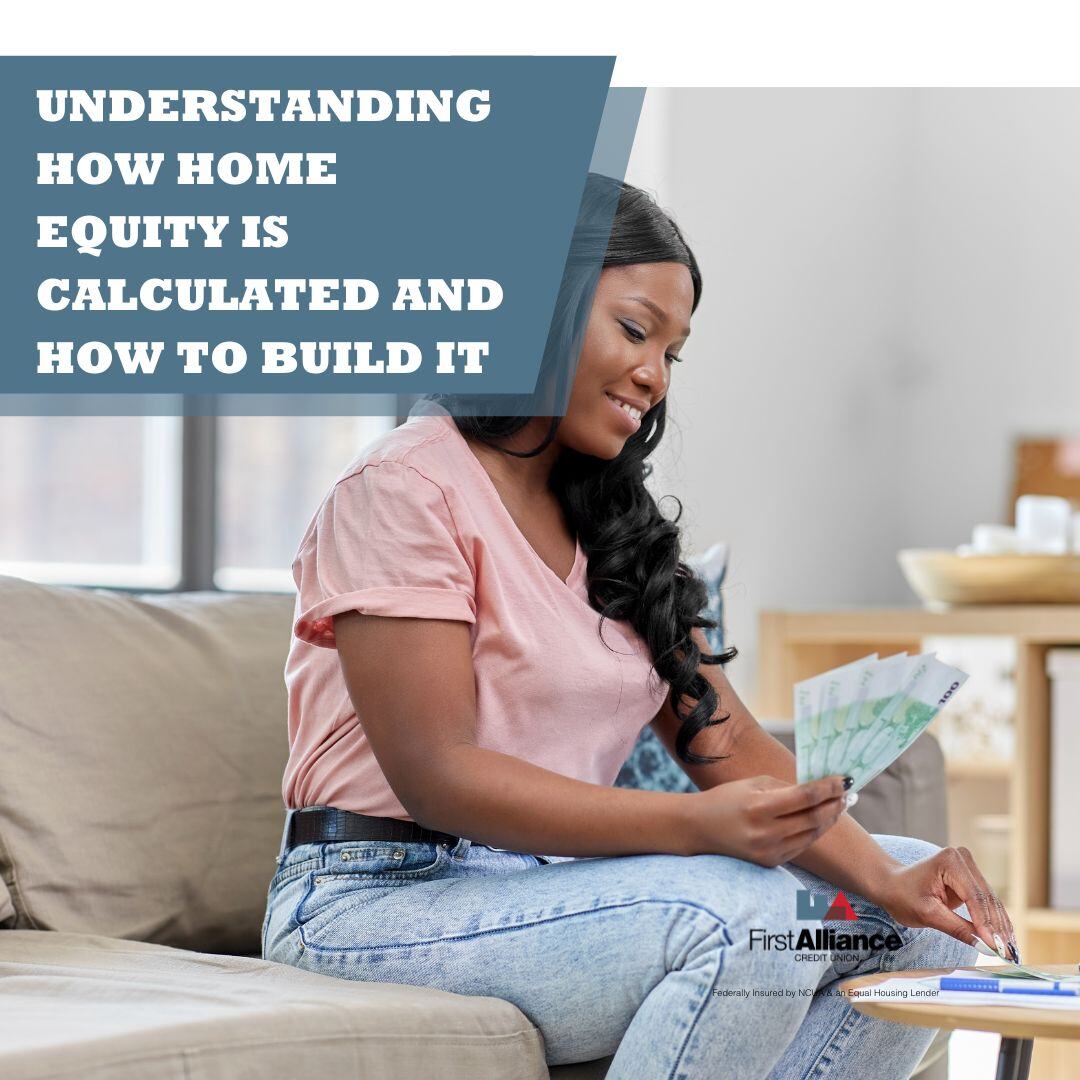For those new to online banking: click here to get started.
7 min read
 Kamel LoveJoy
:
Jul 4, 2024 5:30:00 AM
Kamel LoveJoy
:
Jul 4, 2024 5:30:00 AM

Building equity in your home is a crucial financial strategy, especially for those just starting out. Let’s dive into what home equity is, how you can build it, and the ways you can use it to your advantage.
Home equity is the portion of your home that you truly own. It’s the difference between your home’s market value and what you owe on your mortgage. For example, if your home is worth $200,000 and you owe $150,000, your equity is $50,000.
To determine how much equity you have, subtract the amount you still owe on your mortgage from your home’s current market value.
Why is equity important? Over time, as you pay down your mortgage and your home’s value increases, your equity grows. This can provide financial security and funds for other investments or major expenses, such as education or home improvements. Equity acts as a financial cushion and can be a source of wealth that you can tap into when needed.
Building equity in your home can be achieved through several strategic actions. Let's explore some effective methods to increase your home equity.
Each month, making mortgage payments reduces the amount you owe. Understanding amortization can help clarify this process. Amortization is the gradual reduction of your loan balance over time through regular payments. Initially, a larger portion of your payment goes toward interest, but over time, more goes toward the principal. As you pay down your mortgage, your equity increases.
Improving your home can make it more comfortable and increase its value. Simple upgrades like updating the kitchen, bathroom, or landscaping can make a big difference without breaking the bank. Even small improvements like fresh paint, new fixtures, or modern appliances can boost your home’s market value.
Kitchens and Bathrooms: These rooms often provide the highest return on investment. Updating appliances, countertops, and fixtures can significantly increase your home’s value. You don’t need to do a full remodel—simple changes like new lighting or fixtures can make a big impact.
Basement or Attic: Converting your attic or basement into livable space is another smart way to boost your home’s value. Even adding one functional room can significantly increase your home's worth. Potential buyers love the flexibility, whether it’s used as a home office, guest room, or in-law suite.
Energy Efficiency: Improving your home’s energy efficiency can lower utility bills and increase its value. Consider installing energy-efficient windows, updating your thermostat, or switching to energy-efficient appliances. These changes not only save money but also make your home more appealing to buyers.
Curb Appeal: Enhancing your home’s exterior with landscaping, painting, or adding a new front door can make a strong first impression and boost your home’s value.
Home values tend to rise over time. On average, homes appreciate by about 3% per year. If you live in an area where property values are increasing and you maintain your home well, your equity will grow.
For instance, if your home’s value increases from $250,000 to $335,979 over ten years (a 3% annual increase), your equity would be $149,771 after paying down your mortgage.
When buying a home, putting down a larger down payment increases your immediate equity. This can help you build equity faster as you continue to make mortgage payments. A larger down payment reduces your mortgage balance, meaning more of your monthly payments go toward building equity rather than paying interest.

Certain areas of your home offer higher returns on investment when improved:
These rooms often provide the highest return on investment. Updating appliances, countertops, and fixtures can significantly increase your home’s value. You don’t need to do a full remodel—simple changes like new lighting or fixtures can make a big impact.
Quick Kitchen Upgrades: Install modern appliances, add a fresh coat of paint to cabinets, replace countertops, and update fixtures. These changes can make your kitchen more attractive and functional.
Bathroom Enhancements: Replace the mirror, update the lighting, add new sink and shower fixtures, replace toilet seats, and caulk the tub or shower. Changing the tile can further enhance your improvements.
Converting your attic or basement into livable space is another smart way to boost your home’s value. Even adding one functional room can significantly increase your home's worth. Potential buyers love the flexibility, whether it’s used as a home office, guest room, or in-law suite.
Improving your home’s energy efficiency can lower utility bills and increase its value. Consider installing energy-efficient windows, updating your thermostat, or switching to energy-efficient appliances. These changes not only save money but also make your home more appealing to buyers.
Energy-Efficient Windows: These can reduce heating and cooling costs, making your home more comfortable and attractive to buyers.
Smart Thermostats: Installing a smart thermostat can help regulate your home’s temperature more efficiently, saving money on energy bills.
Energy-Efficient Appliances: Switching to energy-efficient appliances can reduce utility costs and make your home more appealing to eco-conscious buyers.
Enhancing your home’s exterior with landscaping, painting, or adding a new front door can make a strong first impression and boost your home’s value. Simple improvements like a well-maintained lawn, fresh paint, and a welcoming entryway can significantly enhance your home’s curb appeal.
Once you’ve built up equity, there are several ways to use it:
A Home Equity Loan (HEL) gives you a lump sum of money to be repaid over a fixed period, often with a fixed interest rate. A Home Equity Line of Credit (HELOC) allows you to borrow as needed, up to a certain limit, and you only pay interest on what you borrow. Both options can be used for home improvements, education, debt consolidation, or other large expenses.
Home Equity Loan (HEL): This type of loan provides a lump sum of money at a fixed interest rate. You make regular payments over a set period, and the payment amount stays the same every month, including both interest and principal.
Home Equity Line of Credit (HELOC): A HELOC lets you borrow against your home’s equity up to a certain limit. You can borrow money as needed, and you only pay interest on the amount you borrow. This option offers flexibility for financing various expenses.
When you sell your home, the equity is converted into cash after paying off your mortgage. This can provide funds for a down payment on a new home or other investments. Selling your home can be a strategic move if you plan to relocate or upgrade to a larger property.
Refinancing a loan involves replacing your old loan with a new one, often to get better terms. This can mean changing the loan type, interest rate, or payment plan. Refinancing can also allow you to cash out some of your equity or shorten the loan term, potentially lowering monthly payments.
Cash-Out Refinance: This option allows you to take out a new mortgage for more than you owe on your current mortgage, and you receive the difference in cash. This can be used for home improvements, debt consolidation, or other expenses.
Rate-and-Term Refinance: This type of refinancing aims to change the interest rate or the term of your mortgage. It can help lower your monthly payments or shorten the loan term, saving you money in the long run.
.jpg?width=1200&height=630&name=Understanding%20How%20Home%20Equity%20is%20Calculated%20and%20How%20to%20Build%20It%20-%20A%20house%20for%20rent%20(1).jpg)
Building equity in a multi-unit or multifamily home involves similar strategies to a single-family home, with some additional considerations:
Regularly adjusting rent to market rates can increase your income and the property’s value. Consider adding pet fees, appliance rentals, or parking fees to boost income.
Rent Adjustments: Ensure your rental rates are competitive and reflect the current market. This can increase your rental income and overall property value.
Additional Fees: Charging for additional services like parking, pet fees, or appliance rentals can boost your income and property value.
Keeping the property well-maintained and ensuring tenant satisfaction can reduce turnover and vacancies, maintaining steady income and property value. Effective property management involves regular maintenance, prompt repairs, and good tenant relationships.
Maintenance: Regularly inspect and maintain the property to prevent issues and ensure a safe, comfortable living environment for tenants.
Tenant Satisfaction: Respond promptly to tenant concerns and requests. Happy tenants are more likely to stay longer, reducing vacancy rates.
Improving individual units or common areas can enhance the property’s appeal and value. Adding bedrooms and bathrooms can also increase the property's worth.
Unit Upgrades: Update kitchens, bathrooms, and flooring in individual units to make them more attractive to potential tenants.
Common Areas: Enhance shared spaces like lobbies, laundry rooms, and outdoor areas to increase the property’s overall appeal.
To apply for a home equity loan or line of credit, you typically need:
Lenders look for a good credit history to ensure you can repay the loan. A higher credit score can help you secure better interest rates and loan terms.
You’ll need enough equity in your home, usually at least 15-20% of its value. Lenders use this as a measure of how much you can borrow against your home.
Proof of steady income, such as pay stubs, tax returns, or bank statements, is necessary to show you can make the loan payments. Lenders want to ensure you have the financial stability to repay the loan.
An appraisal determines your home’s current market value, ensuring there’s enough equity to borrow against. This step helps the lender assess the risk and determine the loan amount.
Set up extra mortgage payments three times a year.
Adding extra money to your monthly mortgage payment helps reduce the principal amount faster. This means you can pay off your mortgage sooner and remove private mortgage insurance (PMI) quicker if you have it. You can request to remove PMI once the principal amount is 80% of your home's original value.
Let’s say you have a $180,000, 30-year mortgage with a 4% interest rate. Here’s how extra payments can help:
Quarterly Extra Payment: Making one extra payment every three months can cut 11 years off your mortgage, saving you almost $50,000 in interest.
Monthly Extra Payment: Divide your monthly payment by 12 and add that amount to each payment, or pay half your payment every two weeks. This plan makes one extra payment per year, saving you $20,000 and cutting four years off your mortgage.
Small Monthly Increase: If you can’t make a full extra payment, round up your monthly payments to add a few extra dollars. Increase your payment further when you get a raise or bonus. This small extra amount can save you a lot in interest over time.
By following these simple strategies, you can pay off your mortgage faster and save money.
Understanding home equity and how to build it can help you make wise financial decisions and move towards a more secure future. By making smart improvements and managing your finances carefully, you can build significant equity in your home, providing opportunities for investment and growth. At First Alliance Credit Union, we're here to support you every step of the way. If you have any questions or need assistance, don't hesitate to reach out.


When you buy a house, you’re not just getting a nice place to call your own. You’re also buying one of the few assets that tends to increase in value...

A home equity loan is when a lender loans you money against your home’s equity. Payments are made every month on top of your existing mortgage. Being...